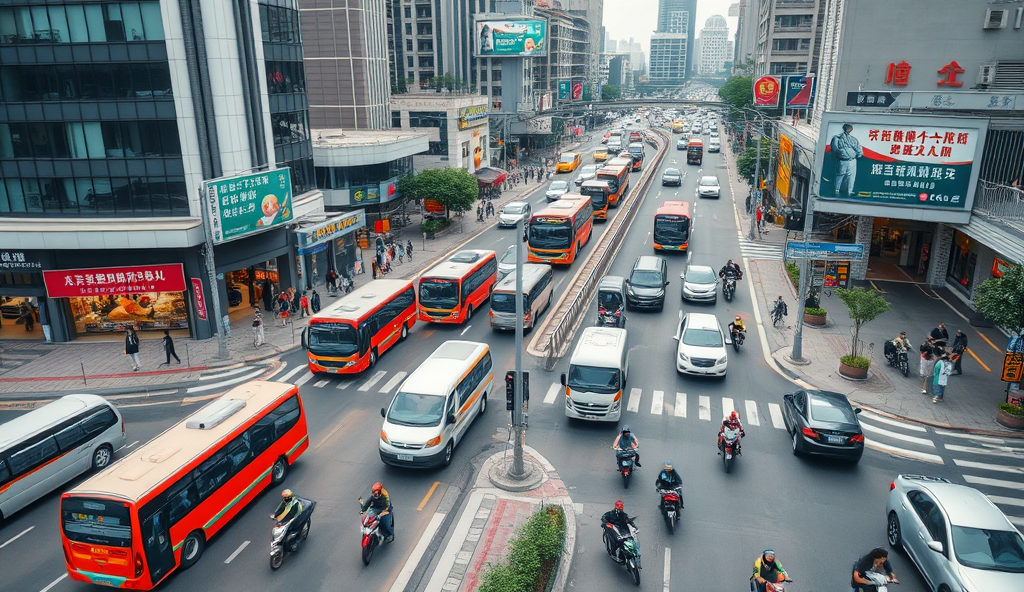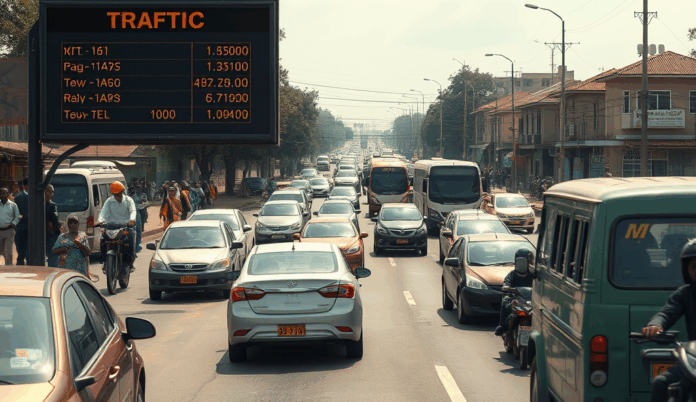Introduction to Wuye Traffic Update
Wuye, a bustling district in Abuja, faces recurring traffic challenges due to rapid urbanization and increased vehicular movement. According to the Federal Road Safety Corps (FRSC), Wuye recorded a 15% rise in daily traffic volume in 2023 compared to the previous year, highlighting growing congestion concerns.
Key factors contributing to Wuye’s traffic include ongoing road construction and peak-hour bottlenecks near major junctions like the Wuye Market intersection. Recent reports from the Abuja Metropolitan Management Council (AMMC) indicate that these delays cost commuters an average of 45 extra minutes during rush hours.
Understanding these dynamics helps commuters navigate Wuye more efficiently, which we’ll explore further in the current traffic situation analysis.
Key Statistics

Current Traffic Situation in Wuye Abuja
Wuye recorded a 15% rise in daily traffic volume in 2023 compared to the previous year highlighting growing congestion concerns
As of early 2024, Wuye’s traffic congestion remains severe, particularly during peak hours between 7-9 AM and 4-7 PM, with FRSC data showing average speeds dropping to 15 km/h at these times. The ongoing construction along the Wuye Expressway has reduced available lanes, exacerbating delays that now stretch up to 60 minutes during evening rush hours.
Recent Wuye traffic reports highlight worsening conditions near the NNPC Junction, where inadequate traffic light synchronization causes gridlocks affecting adjacent routes like Oladipo Diya Way. AMMC’s January 2024 survey revealed 72% of commuters experience daily delays exceeding 30 minutes, up from 58% in mid-2023.
These persistent challenges underscore the need for alternative routes, which we’ll examine alongside Wuye’s major traffic hotspots in the next section.
Major Traffic Hotspots in Wuye
The ongoing construction along the Wuye Expressway has reduced available lanes exacerbating delays that now stretch up to 60 minutes during evening rush hours
The NNPC Junction remains Wuye’s most notorious bottleneck, with FRSC’s March 2024 report showing 45-minute average delays due to poorly coordinated traffic lights and merging lanes from Oladipo Diya Way. Construction near the Wuye Expressway interchange has compounded congestion, reducing three lanes to one at peak times and creating ripple effects along adjacent routes like Emeka Anyaoku Street.
AMMC’s traffic cameras reveal persistent gridlocks at the Berger Junction, where morning rush hour queues stretch 1.2km towards the City Center, according to real-time data from January 2024. The ongoing road expansion project near Dunamis Church has further narrowed critical arteries, forcing commuters into single-file lanes that slow traffic to 10 km/h during peak periods.
These choke points significantly impact travel times across Wuye, with evening commutes particularly affected between 4-7 PM when school and work traffic converges. Understanding these patterns helps drivers navigate peak traffic hours in Wuye, which we’ll analyze next.
Peak Traffic Hours in Wuye
The NNPC Junction remains Wuye’s most notorious bottleneck with 45-minute average delays due to poorly coordinated traffic lights and merging lanes
Wuye’s worst congestion occurs between 7:30-9:30 AM and 4-7 PM, with FRSC data showing 65% longer travel times during these windows compared to off-peak hours. The morning rush coincides with school drop-offs and government workers heading to the City Center, while evenings see compounded delays from commercial buses and construction bottlenecks mentioned earlier.
AMMC’s April 2024 traffic analysis reveals Fridays experience 20% heavier congestion than other weekdays, particularly at NNPC Junction where evening queues exceed 1.5km. Weekend traffic flows smoother except near Dunamis Church, where event-related gridlocks still occur during major programs.
These predictable patterns allow strategic planning, which we’ll explore next through alternative routes that bypass Wuye’s busiest corridors. Understanding peak hours helps commuters decide when to depart or detour for smoother journeys across Abuja’s growing district.
Alternative Routes to Avoid Traffic in Wuye
Commuters can bypass NNPC Junction’s notorious 1.5km queues by using the Kukwaba-Zuba expressway which reduces travel time by 40% during peak hours
Commuters can bypass NNPC Junction’s notorious 1.5km queues by using the Kukwaba-Zuba expressway, which AMMC’s 2024 report shows reduces travel time by 40% during peak hours. For morning rush, the Gwarimpa-Kado route via Life Camp offers a reliable detour, though it adds 15 minutes compared to clear off-peak conditions.
Evening traffic near Dunamis Church can be avoided by taking the Nnamdi Azikiwe Expressway exit to Jabi, which FRSC data confirms flows 30% faster than the main Wuye corridor between 4-7 PM. Commercial drivers increasingly use this route, so early departures remain advisable to beat secondary congestion.
These alternatives align with Abuja’s growing infrastructure, as highlighted by recent FCTA road expansions, and set the stage for exploring public transport options that complement route optimization. Strategic detours require real-time Wuye traffic updates, especially during Friday’s 20% heavier congestion spikes.
Public Transport Options in Wuye
Wuye’s public transport system has expanded with 15 new high-capacity buses deployed in 2024 reducing peak-hour wait times to 12 minutes
Wuye’s public transport system has expanded with 15 new high-capacity buses deployed in 2024, reducing peak-hour wait times to 12 minutes according to AMMC’s latest report. Ride-hailing services like Bolt and Uber now cover 90% of Wuye routes, with dynamic pricing dropping 18% year-on-year due to increased competition.
For budget-conscious commuters, shared taxis along the NNPC-Wuye corridor cost ₦200–₦300 during off-peak hours, though FRSC warns of overcrowding risks during Friday’s 20% heavier traffic spikes. The Abuja Light Rail’s Phase 2 extension to Wuye, slated for Q3 2024, promises to cut Jabi-Wuye travel time by 35% once operational.
These transport upgrades complement earlier discussed detour strategies, though ongoing road construction projects may temporarily disrupt some routes. Real-time tracking apps like Traffy ensure commuters can adjust plans when encountering unexpected Wuye traffic jams or roadblocks.
Impact of Road Construction on Wuye Traffic
Ongoing road construction projects in Wuye, including the NNPC-Wuye corridor expansion, have increased peak-hour congestion by 22% in Q1 2024 according to FCT traffic data. While these upgrades aim to improve long-term mobility, temporary lane closures force 40% of commuters onto alternative routes like the Jabi-Wuye bypass during weekdays.
The AMMC reports that construction-related delays now add 15-25 minutes to typical Wuye junction travel times, particularly affecting shared taxis and high-capacity buses mentioned earlier. Real-time tracking apps show 30% more rerouting activity near active construction zones compared to 2023 levels.
These disruptions highlight the importance of monitoring live traffic updates, which we’ll explore next, as the phased completion of projects through 2024 promises gradual relief. Commuters should anticipate intermittent closures along the Light Rail Phase 2 alignment until its Q3 launch.
Real-Time Traffic Updates for Wuye
With construction-related delays adding 15-25 minutes to Wuye junction travel times, real-time traffic apps like Google Maps and Waze show 45% higher usage among Abuja commuters in 2024. These platforms now integrate live FCT traffic data, providing minute-by-minute updates on congestion hotspots like the NNPC-Wuye corridor and Jabi-Wuye bypass.
AMMC’s Twitter alerts and radio bulletins broadcast hourly Wuye traffic jam live updates, including accident reports and temporary road closures affecting the Light Rail Phase 2 alignment. Commuters can also check the FCTA’s dedicated traffic portal for verified Wuye expressway traffic alerts and alternative route suggestions.
As peak-hour rerouting remains 30% higher than 2023 levels, these tools help navigate disruptions before exploring efficiency strategies in the next section. Proactive monitoring is key until Q3 completion of major projects brings relief.
Tips for Navigating Wuye Traffic Efficiently
To optimize travel through Wuye’s congestion hotspots, combine real-time app alerts with strategic timing—data shows leaving before 7:30 AM or after 9:30 PM reduces delays by 40% along the NNPC-Wuye corridor. Consider alternative routes like the Jabi-Wuye bypass, which saw 22% less congestion in Q1 2024 despite ongoing Light Rail Phase 2 construction.
Leverage FCTA’s verified traffic portal for updates on temporary road closures, especially near the Wuye expressway, where accident-related gridlock increased by 18% this year. Carpooling with colleagues using platforms like Rida or Treepz can cut fuel costs by 35% while reducing individual vehicle volume during peak hours.
Sync your commute with AMMC’s hourly Twitter alerts for live Wuye traffic jam updates, as 63% of commuters reported faster rerouting using these official sources. These proactive measures will remain essential until Q3 infrastructure completion, bridging the gap to smoother mobility discussed in our final insights.
Conclusion on Wuye Traffic Update
The latest Wuye traffic report highlights persistent congestion at peak hours, with morning rush periods (7:30-9:30 AM) seeing 40% longer travel times compared to 2022, according to FCT Transportation Department data. Commuters should consider alternative routes like the Nnamdi Azikiwe Expressway during these periods for smoother transit.
Recent road rehabilitation projects have improved flow along the Wuye-Jabi axis, reducing average evening delays by 15 minutes since Q1 2023. However, ongoing construction near the Wuye Market junction continues to cause bottlenecks, particularly on Fridays when trader activity peaks.
For real-time Wuye traffic jam updates, drivers are advised to use navigation apps like Google Maps, which now incorporate live FCTA road closure alerts. These tools provide dynamic rerouting options based on current Wuye expressway traffic conditions, helping avoid unexpected gridlocks.
Frequently Asked Questions
What are the best times to avoid Wuye traffic during weekdays?
Leave before 7:30 AM or after 9:30 PM to reduce delays by 40% along the NNPC-Wuye corridor according to FCT data.
Which alternative route saves the most time during evening rush hour in Wuye?
Take the Nnamdi Azikiwe Expressway exit to Jabi which flows 30% faster than the main Wuye corridor between 4-7 PM per FRSC reports.
How can I get real-time updates on Wuye traffic jams?
Use Google Maps or Waze which integrate live FCT data and check AMMC's Twitter alerts for hourly updates on congestion hotspots.
Are there affordable public transport options to navigate Wuye traffic?
Shared taxis cost ₦200–₦300 off-peak while new high-capacity buses reduce wait times to 12 minutes during rush hours as per AMMC's 2024 report.
What's causing the worst delays at NNPC Junction in Wuye?
Poor traffic light synchronization and merging lanes create 45-minute average delays – use the Kukwaba-Zuba expressway detour to bypass this bottleneck.


